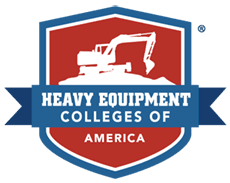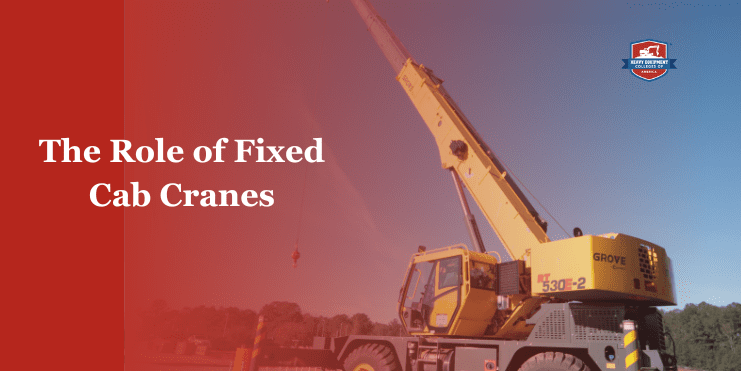Fixed cab cranes are used widely throughout the heavy equipment industry, particularly in industrial settings. As the name suggests, fixed cab cranes have a fixed cab that resembles a truck cab. Unlike swing cab cranes—which feature a 360-degree view swiveling cab—the cab on fixed cab cranes doesn’t rotate, resulting in operators only being able to see what’s directly in front of or to the side of them.
Want to learn more about what fixed cab cranes are used for and how to operate them safely? Check out our guide below.
Table of Contents
Fixed Cab Crane Functions in Infrastructure Projects
- Bridge Construction
Floating cranes are often used to construct bridges because they float on the water, making them useful for loading and unloading heavy materials from cargo ships. - Road & Highway Construction
The mobility of rough terrain cranes on uneven terrain makes them ideal for highway construction. - Railway Construction
Railroad cranes are used to build railway lines and maintain and repair railroads because their wheels are designed specifically to move along rail tracks. - Airport Construction
Cranes are used in airport construction to complete projects like adding new terminals and building on-site hotels. Due to the constant activity at airports, marking designated work zones is key to ensuring worker safety. This can include placing colorful flags or lights along the perimeter of the work zone.
Fixed Cab Crane Functions in Urban Development
- High-Rise Building Construction
Aerial cranes are used to construct high-rises because they’re precise even when the target is hard to reach due to increased height. - Old Building Demolition
Many old buildings that need to be demolished are situated among a block of buildings in crowded urban areas. Common tactics like explosive demolition aren’t possible. Cranes allow for the safe, gradual removal of parts of the building. Thanks to their extension capabilities, they can reach even the tallest of buildings. - Utility Installation
Fixed cab cranes are primarily used to install pipes, power lines, and other utility materials. - Urban Renewal & Revitalization
Tower cranes strike the perfect balance between lifting capacity and lifting height, making them ideal for constructing tall buildings in urban renewal and revitalization projects.
The Evolution of Heavy Equipment Safety Standards and Regulations
Safety & Regulations
Even the safest, most advanced fixed cab cranes pose some safety risks. That’s why it’s important to know how to maintain cranes and operate them safely on job sites. If used incorrectly, cranes can cause injuries and even death.
Here are the regulatory and safety standards a crane and crane operator must meet.
OSHA Regulations for Crane Operations
OSHA (the Occupational Safety & Health Administration) outlines the following key regulations for fixed crane operators:
- Effective as of November 10, 2018: Crane operators must be certified. Certifications may be by type alone and must be issued by an accredited certifying body such as NCCCO.
- Effective as of February 7, 2019: Employers must evaluate their crane operators according to specified criteria and a stipulated process.
- Effective as of April 5, 2019: Employers must ensure all documentation relating to their evaluations is current.
Training & Certification Requirements for Crane Operators
General crane training and certification are no longer adequate for safe crane operation. Crane operators must be trained and certified for each crane type they will operate on the job.
According to section 1926.1427 of OSHA guidelines, “the employer must provide each operator-in-training with sufficient training, through a combination of formal and practical instruction, to ensure that the operator-in-training develops the skills, knowledge, and ability to recognize and avert risk necessary to operate the equipment safely for assigned work.” Additionally, “the employer must ensure that each operator is certified or licensed to operate the equipment.”
These requirements ensure the safety of heavy equipment operators, other workers on the job site, and bystanders by minimizing the risk of human error.
Best Practices for Ensuring Safe Crane Operations
- Plan Ahead: Any successful construction project starts with a well-designed plan. Know what load you will lift with what type of fixed cab crane.
- Calculate Lift Capacity: Determine how much the crane can carry. Do this by weighing the load and comparing it to the lift capacity as outlined in the user manual. The load’s weight should never exceed the crane’s lift capacity.
- Perform a Crane Check: Perform a thorough check of crane equipment before starting a project to ensure proper function. Any outdated, damaged, or malfunctioning equipment should be either repaired or replaced.
- Assess Potential Hazards: When choosing where to position the crane for operation, scan the area for obstructions like power lines or light poles.
The Future of Fixed Cab Cranes in Infrastructure Projects & Urban Development
Technological Advancements & Emerging Trends
Here are some of the key technological advancements that have made today’s fixed cab cranes safer, more efficient, and more user-friendly than ever before.
- Intelligent Service Panels: Operators can detect and correct equipment issues more quickly, helping employers extend the crane’s lifecycle.
- Remote Monitoring Capabilities: Sensors collect usage and condition data about machine operation to improve overall productivity and safety.
- Load Weight & Positioning Detection: This feature helps operators determine the best location for crane operation on the job site.
- Optimized Pulley Rope Angles: This modern pulley system reduces the strain placed on wire hoisting ropes, which helps them last longer.
- Compact Size: The smaller size of fixed cab cranes makes them more energy-efficient and versatile than in the past.
Environmental Considerations & Sustainability
Due to increased concerns about sustainability in the construction industry, many modern cranes are made with recyclable materials to reduce material waste and carbon emissions during the manufacturing process. They also feature lower fuel consumption during operation.
Enroll in Our Fixed Cab Crane Operation Program
Do you want to become a certified fixed cab crane operator? Earn your Certificate of Fixed Cab Crane Operation With Rigging and Signaling at Heavy Equipment Colleges of America (HEC). Our fixed cab crane operation program will teach you the fundamental knowledge and skills required for effective operation so you can secure employment as a fixed cab crane operator, rigger, or signalperson.
This training program is offered at our Georgia, California, and Oklahoma locations and can be completed in as little as three weeks. Take the first step by starting the enrollment process.





